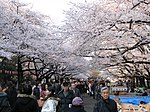Yushima Tenmangū
Buildings and structures in BunkyōShinto shrines in TokyoSugawara no MichizaneTenjin faithUeno, Tokyo

Yushima Tenman-gū (湯島天満宮) is a Shinto shrine located in the Bunkyō ward of Tokyo, Japan. Established in 458, it is now devoted to Tenjin, the kami of Learning. For this reason, it is also called Yushima Tenjin. It is located very close to Ueno Park, and not far from the University of Tokyo. It is a frequently sited by prospective students hoping to pass the entrance exams, particularly in April. At this time, the temple receives many offerings of ema, votive tablets to petition the kami for success.One of the most famous features of the shrine are the blossoms of his plum trees (ume) in the spring. In February and March, the annual festival Ume Matsuri is held, attracting many visitors.
Excerpt from the Wikipedia article Yushima Tenmangū (License: CC BY-SA 3.0, Authors, Images).Yushima Tenmangū
湯島天満宮 女坂, Bunkyo
Geographical coordinates (GPS) Address Nearby Places Show on map
Geographical coordinates (GPS)
| Latitude | Longitude |
|---|---|
| N 35.707777777778 ° | E 139.76833333333 ° |
Address
本殿
湯島天満宮 女坂
110-0005 Bunkyo
Japan
Open on Google Maps











